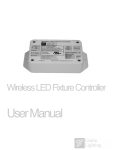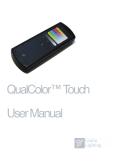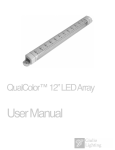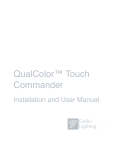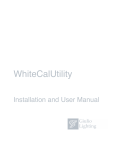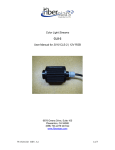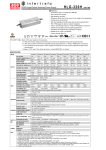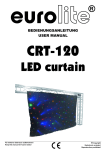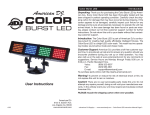Download User Manual - Giulio Lighting
Transcript
Wireless Single Fixture DMX Controller
User Manual
Important Information
Please read through these notes and the remaining instructions before installing this
device.
1. Refer to local and state codes to ensure compliance when installing this
device. Consult an Electrical Inspector if you have any questions.
2. Use only with a listed Class 2 or Limited Power Source external power
supply.
3. Be sure to use cables specified for use with DMX systems.
4. Be sure to terminate the DMX chain.
5. Do not exceed a maximum of 30 DMX devices.
6. Do not exceed a maximum of approximately 1000 feet (300 m) for the entire
DMX cable run.
7. Make sure that power is disconnected before connecting or disconnecting
any DMX devices.
8. Make sure this device and its power supply are located in a dry
environment.
9. Be sure to plan the installation before beginning.
1
Model CT-001
The Model CT-001 Wireless Single Fixture DMX Controller is part of the QualColor™
family and controls a white or color-capable DMX light fixture. Integrating a wireless
receiver with the sophisticated Giulio Lighting LEDsmarts system, the CT-001 allows
full control over a lighting system’s color and intensity. The CT-001 can be operated
by any Giulio Lighting controller using the LEDlink wireless interface.
Feature
Benefit
LEDlink digital radio interface
Allows easy installation of lighting
system components.
DMX fixture interface
Easy connection to a multitude of
different fixtures using tools and
cabling most installers already
have.
Selectable DMX channel formats
and assignments
Supports a wide variety of fixture
types. The CT-001 controller can
operate fixtures with different RGB
channel assignments, master
brightness channels, additional
color channels such as white or
amber or alternative color encoding
schemes such as HSI.
LEDsmarts fader
Allows any number of fixtures to be
operated by one control by
distributing the fading operation to
the fixture controllers.
LEDsmarts automatic programs
Allows fixtures to operate
independently of the remote
controlling device.
2
Introduction
Wireless Single Fixture DMX
Controller
Feature
Benefit
Configurable Link attributes
Allows multiple controllers to coexist and to handle radio
interference from external sources.
Configurable address
Allows sophisticated installations
with independently operating
fixtures.
Configurable calibration
Allows tuning of the white light
generated by fixtures generating
using RGB or RGBA LED
configurations.
Small size
Easily hidden in a convenient
location.
Device Description
The CT-001 is designed to control a DMX light fixture. The fixture may be a single-channel
white light fixture or a multi-channel color-capable fixture. The CT-001 controls only intensity
when configured to control a single-channel white light fixture. The CT-001 controls intensity
and color of a multi-channel color-capable fixture.
The CT-001 generates DMX frames consisting of Start Code with a value of 0 followed by 128
8-bit data slots. The 128 data slots consist of 8 unique data bytes repeated 16 times. The
CT-001 maps the data to control the light into the 8 unique data bytes. The mapping is
configurable and described in the section “DMX Channel Configuration”.
The CT-001 can drive up to 30 fixtures. However each fixture must have the same DMX
address and use the same mapping of channels to slots. All fixtures will operate identically.
3
CT-001 controls and connectors are shown in the following illustration.
1
2
3
5
4
2
3
6
7
8
1
Side Views
Item
Description
1
Power Input Jack. Provides power for the CT-001. Connect to a 6
volt DC Class 2 or Limited Power Source.
2
Power Indicator. Green indicator that is lit when the CT-001 is
receiving power.
3
CT-001 Configuration. Nine recessed DIP switches used to configure
the the CT-001 with the fixture characteristics. The operation of these
switches is described in the section “DMX Channel Configuration”.
4
DMX Output Connector. Three-pin XLR female connector that
drives the DMX output signals.
Pin 1: Ground/Screen
Pin 2: Data Pin 3: Data +
5
RF Error Indicator. Red indicator that blinks when the CT-001
detects a missed packet. Excessive blinking of this indicator
indicates poor reception by the CT-001.
6
RF Activity Indicator. Green indicator that blinks each time the
CT-001 receives a packet over the LEDlink RF interface.
7
Prog Indicator. Red indicator that is lit when the CT-001 is put into
Provisioning Mode (the Prog Button is pressed). Remains lit until an
external device successfully provisions the CT-001, the Prog Button is
pressed a second time or a one hour period expires.
4
Item
Description
8
Prog Button. Recessed button used to put the CT-001 into and out of
Provisioning Mode. See section “Provisioning” for a more detailed
description of the provisioning process.
DMX Channel Configuration
There is no standard among fixture manufacturers for the mapping of color channels in a
fixture to DMX channels. The CT-001 must be configured to drive the appropriate data in each
DMX slot. It can drive data in up to eight DMX slots. The same data is repeated every eight
slots for the entire frame. The CT-001 supports fixtures that utilize the following information.
• Intensity only: Used for white light fixtures. Supports 256 intensity levels.
• RGB: Used for color-capable light fixtures. Supports 256 intensity levels on three color
channels (RGB).
• RGBA: Used for color-capable light fixtures. Supports 256 intensity levels on four
color channels (RGBA or RGBY).
• RGBW: Used for color-capable light fixtures. Supports 256 intensity levels on three
color channels (RGB) and one white color channel.
• HSI: Used for color-capable light fixtures. Supports 256 levels on three color control
channels (Hue, Saturation, Intensity).
In addition to intensity or color channel information the CT-001 can drive specific values in
particular slots for fixtures that need additional control information such as master intensity.
The CT-001 is configured in one of two ways: through DIP switches on the side of the unit or
via a utility program running on a computer that communicates with the CT-001 via the
LEDlink interface.
• DIP Switches: Allows configuring operation of a white-only fixture or a RGB colorcapable fixture that maps the color channels sequentially in the order R-G-B. The
RGB color-capable fixture may also have a separate master intensity channel.
• External Utility Program: Allows full configuration of the CT-001 including RGBA,
RGBW or HSI fixtures, arbitrary mapping of color channels and custom control
channel values. A description of this configuration method is beyond the scope of this
document. Please see the instructions that come with the utility program for the
control device that will be used with the CT-001.
5
The remainder of this section describes use of the DIP switches to configure the CT-001. As
shown in the following diagram, there are nine individual switches numbered 1-9. A switch is
considered “on” when in the up or “1” position. It is considered “off” when in the down or
“0” position. The DIP switches should be configured prior to installation.
1
9
1
0
Aux Channel
Start Channel
Enable Aux Channel
Enable Color
Enable DMX Switches
Switch
Description
1
Enable DMX Switches. Setting this switch to “on” enables the
remaining DIP switches to configure the CT-001. Setting this switch
to “off” enables the internal configuration set by the External Utility
Program. The remaining switches are ignored when this switch is in
the “off” position.
2
Enable Color. Setting this switch to “on” enables the CT-001 to
control a color-capable fixture that utilizes red, green and blue
channels. The red, green and blue channels must be in sequential
order (for example, Red on channel 1, Green on channel 2 and Blue
on channel 3). Setting this switch to “off” enables the CT-001 to
control a white fixture that utilizes a single channel for intensity.
3
Enable Aux Channel. Setting this switch to “on” enables the CT-001
to drive a value of 255 on one of the eight channels in order to set a
fixture master intensity control to full. The Aux Channel switches set
the channel number. Setting this switch to “off” disables the CT-001
from driving an additional value for a master intensity channel.
6
Switch
Description
4-6
Start Channel. These three switches select the starting channel for
the intensity or color information. They specify the single channel
that carries the intensity information when the Enable Color switch is
set to “off”. They specify the three consecutive channels carrying
red, green and blue information when the Enable Color switch is set
to “on”.
The channel value ranges from 1 to 8 depending on the switch
settings as shown in the following table. Looking at the switches
from left to right (Switch 4 - Switch 5 - Switch 6).
000: Start Channel = 1
001: Start Channel = 2
010: Start Channel = 3
011: Start Channel = 4
100: Start Channel = 5
101: Start Channel = 6
110: Start Channel = 7 (not valid for Color fixtures)
111: Start Channel = 8 (not valid for Color fixtures)
7-9
Aux Channel. These three switches select the channel used for the
value of 255 when the Enable Aux Channel switch is set to “on”.
Looking at the switches from left to right (Switch 7 - Switch 8 Switch 9).
000: Aux Channel = 1
001: Aux Channel = 2
010: Aux Channel = 3
011: Aux Channel = 4
100: Aux Channel = 5
101: Aux Channel = 6
110: Aux Channel = 7
111: Aux Channel = 8
Channels not used to carry intensity/color information or the Aux value of 255 will contain
the value of 0.
7
The following examples demonstrate use of the DIP switches for typical fixtures.
Example 1
Example 1 shows the configuration for a single-channel white light DMX fixture. The fixture is
configured to look at DMX channel 1 for the intensity information.
• DMX Switches “on”
• Enable Color “off”
• Enable Aux Channel “off”
• Start Channel = 1
• Aux Channel = don’t care
1
0
Example 1: White fixture
Example 2
Example 2 shows the configuration for a three-channel color-capable DMX fixture that utilizes
red, green and blue LEDs. The fixture is configured to start at DMX channel 2. The fixture
looks for red color information on DMX channel 2, green color information on DMX channel 3
and blue color information on DMX channel 4.
• DMX Switches “on”
• Enable Color “on”
• Enable Aux Channel “off”
• Start Channel = 2
• Aux Channel = don’t care
1
0
Example 2: Simple RGB fixture
8
Example 3
Example 3 shows the configuration for a five-channel color-capable DMX fixture that utilizes
red, green and blue LEDs. This fixture is configured to start at DMX channel 3. It has the
following channel mapping.
1. Red color information
2. Green color information
3. Blue color information
4. Reserved by the fixture manufacturer
5. Master Control. A value of 255 on this channel sets the maximum global intensity.
Note that the Aux Channel is enabled and set to 7 so that it will drive the value 255 on the
fixture’s Master Control channel.
• DMX Switches “on”
• Enable Color “on”
• Enable Aux Channel “on”
• Start Channel = 3
• Aux Channel = 7
1
0
Example 3: RGB fixture with master intensity channel
9
LEDsmarts
The CT-001 contains a sophisticated controller called LEDsmarts that manages the LED
fixtures locally. The LEDsmarts controller allows installations of LED lighting systems that do
not depend on any one central controller to manage all lighting effects. Installations may be
controlled by multiple control devices and may even operate independently of any controller.
The CT-001 LEDsmarts controller includes the following capabilities.
• Color fader: The CT-001 manages transitions from one color and intensity to another
one automatically and independently.
• Automatic programs: The CT-001 can automatically animate a color-capable fixture
with one of two programs. Each program can change the fixture color at one of four
speed settings.
• Random : The CT-001 fades the fixture(s) smoothly between randomly chosen
colors for an ever-changing light show.
• Slow : 30 - 180 seconds for each color change.
• Medium/Slow : 10 - 60 seconds for each color change.
• Medium/Fast : 5 - 30 seconds for each color change.
• Fast : 1 - 6 seconds for each color change.
• Sequential : The CT-001 fades the fixture(s) smoothly between all the hues in the
rainbow.
• Slow : 30 minutes for the complete sequence of colors.
• Medium/Slow : 10 minutes for the complete sequence of colors.
• Medium/Fast : 3 minutes for the complete sequence of colors.
• Fast : 15 seconds for the complete sequence of colors.
• Color space mapping : The CT-001 automatically controls multiple configurations of
LEDs to properly generate colors without requiring any central controllers to have
specific knowledge of the fixture.
10
Addressing
The CT-001 controller supports Zone/Unit addressing with Group support.
• Zone Address: 0-65535. Factory default value of 1.
• Unit address: 0-65535. Factory default value of 1.
• Four Group Addresses: 0-255. Factory default value of 0 for each group address.
Zone addresses are used to associate related fixtures and fixture controllers. For example all
fixtures and fixture controllers in one physical location such as a room may be given the same
Zone address so that they may be controlled together.
Unit addresses are used to control individual lights within a Zone. Each separate fixture or
fixture controller is given a unique Unit address allowing it to be controlled alone.
Group addresses are used to control groups of related fixtures or fixture controllers within a
Zone. All fixtures with the same Group address will respond identically to commands
addressing that group.
11
LEDlink Radio Interface
A CT-001 and one or more other devices communicate using the proprietary LEDlink radio
protocol sharing certain characteristics called a Link. A CT-001 is considered linked to another
device when it and the other device share the same Link attributes. These attributes define the
Link characteristics.
1. Radio channel : Specifies the common frequency the radio transceiver in the CT-001
and other device(s) are tuned to.
2. Network ID : The Network ID is designed to allow multiple, overlapping
installations of fixtures and other controllers to work without interference. The
primary use of the Network ID is to prevent an installation of devices in one
apartment or home from affecting devices in another apartment or home where the
radio signals may overlap. Devices with different Network IDs ignore each other.
3. Device address : Each fixture or fixture controller may be configured with a unique
device address. The CT-001 is configured with the device address for the fixture(s) it
controls.
The factory default configuration for the CT-001 and all LEDlink capable Giulio Lighting
control devices contains the same linking attributes allowing a CT-001 fixture controller to
immediately work with these devices.
Certain conditions may require that one of the Link attributes be changed. Example
conditions include the following.
1. The user desires to have multiple CT-001 fixture controllers, each with a different
address in order to be operated independently.
2. The user desires to change the Radio channel to avoid radio interference from a
device like a microwave oven.
3. The user desires to change the Network ID to avoid interference from a lighting
system in another apartment or home.
Link attributes are changed using a process called provisioning described in the next section.
12
Provisioning
Link attributes and other operating parameters of the CT-001, such as address, are changed by
a process called provisioning. During provisioning an external device communicates the new
Link attributes to the CT-001 over the LEDlink wireless interface. The external device may be
a handheld remote control or some sort of computer interface under the control of software
running on a personal computer. The CT-001 is put into a special mode, called the
Provisioning or Link mode, by pressing the Prog button and and verifying the Prog Indicator
is lit. Typically this is a step described in the User Manual for the device or software being
used to provision the CT-001. The CT-001 will remain in Provisioning mode for up to one
hour before reverting automatically to normal operation. In Provisioning mode the Link
characteristics of LEDlink are set to a known condition so that another device may
communicate with it successfully over the LEDlink.
Advanced Features
The CT-001 supports custom calibration parameters to enhance operation of certain fixture
types.
1. White balance calibration : Adjust the amount of red, green, blue and optionally
amber used when generating white light for RGB and RGBA fixture types. These
calibration parameters allow the user to specify the precise white generated by a
fixture that uses separate color components.
2. Amber/Yellow Channel calibration : Specify the precise color of the Amber channel
in relation to the green and red channels for fixtures using RGBA or RGBY LED
arrays.
Use of these calibration parameters is beyond the scope of this document. Please refer to the
User Manual for the calibration software available on the Giulio Lighting website.
13
14
Installation
Pre-installation
It can be helpful to plan an installation prior to starting to physically install
components.
The following items should be considered when creating the plan.
Provisioning
Provisioning of the CT-001 is required if any link attributes or other operating
parameters must be changed. It may be helpful to provision the CT-001 before
installation in order to place the CT-001 and provisioning device in close proximity
(although the CT-001 can be provisioned or re-provisioned once installed). It is not
necessary to attach any fixture(s) to the CT-001 unless required by the provisioning
process. Locate the CT-001 near the provisioning device (within five feet / 2 m).
Attach the external power supply to the CT-001 and plug the PSU into an outlet.
Press the Prog button to put the CT-001 into Provisioning Mode. Finally follow the
procedures described in the User Manual for the provisioning device or software.
DMX Fixture Configuration
Both the CT-001 and DMX Fixture must have DMX-related attributes configured in
order to work together.
The CT-001 must be configured to drive the necessary information on the correct slots
in the DMX data stream. See the section “DMX Channel Configuration”. The DMX
Fixture starting address must be set to match the data transmitted by the CT-001. This
starting address is typically a value 1 through 8 although the CT-001 repeats the same
information every 8 slots in the DMX data stream.
CT-001 and Power Supply Location and Orientation
Determine the installation location for the CT-001. The location generally depends on
the following factors.
• Location of power outlet. The power supply cable length dictates the
maximum distance from a power outlet to the CT-001 location.
• Access for fixture cabling. The DMX cable connection to the fixture should be
routed in an unobtrusive manner.
• CT-001 position and orientation for best radio reception. The CT-001 should be
located so that there is a clear path for the radio signal from the device that will
control it. Examples locations include on the underside or top of a cabinet or in
a cove. The CT-001 may be located inside a wood cabinet. However it should
never be located inside a metal enclosure or against a metal surface. Note the
orientation arrow on the CT-001 label. The indicated side should be mounted
closest to nearest wall.
15
The CT-001 will typically work up to 100 feet (30 m) from the controlling device outdoors and
50 feet (15 m) indoors. Actual range may vary substantially based on the position and
orientation of the fixture and objects, such as walls, between the CT-001 and the controlling
device. The LEDlink radio communication between the CT-001 and the controlling device is
very robust. However some other devices, including microwave ovens, cordless phones and
Wifi devices, may cause interference. Often changing the radio channel used by the CT-001
can alleviate the interference. See the User Manual for the controlling device or provisioning
software for further instructions on changing the channel.
Fixture Cabling
A DMX cable is routed from the CT-001 to the fixture and from there, in a daisy chain method,
to additional fixtures. The maximum length of the DMX cabling from the CT-001 to the final
fixture or fixture controller is 1000 feet (300 m) as shown in the following illustration.
DMX Fixture
DMX Fixture
Power
External PSU
DMX Terminator
CT-001
DMX Cable
Installation
The installation process consists of the following steps.
1. Mount. The CT-001 is designed to be mounted using the supplied screws.
2. Connect fixture using a DMX cable. Be sure to attach a DMX termination device to
the fixture DMX Out connector. These steps assume that the fixture is installed
according to instructions provided by the fixture manufacturer.
3. Attach power supply. Connect the power supply to the CT-001.
4. Plug power supply into power. Verify the the power indicator is lit.
5. Test installation. Verify correct operation of the installation. The RF Activity LED
should blink as commands are transmitted to the CT-001.
16
Troubleshooting
Please refer to the following table for help troubleshooting an installation.
Problem
Power LED does not light
Possible Cause
No power to outlet.
Power Supply not completely plugged
into the CT-001.
RF indicator does not flash
Controlling device is too far from the
CT-001.
Radio signals are being blocked by
materials surrounding the CT-001.
The CT-001 and the controlling device are
not properly linked (e.g. different radio
channel or Network ID).
RF Error indicator flashes
excessively
Controlling device is too far from the
CT-001.
Radio signals are being blocked by
materials surrounding the CT-001.
Fixture colors are not as expected
The DMX Configuration in the CT-001
does not match the requirements of the
DMX fixture.
The DMX address of the fixture does not
match the channel assignment of the
CT-001.
17
18
Specifications
Functions
Fixture Controller
Controls most DMX lighting
fixtures.
Fixture Support
White-only
RGB
RGBA (RGBY)
RGBW
HSI
Control channel overrides
Automatic Functions
Pseudo-random color selection with
four selections for rate of change.
Sequential color selection with four
selections for rate of change.
Fixture Calibration
RGB White calibration
RGBA Amber/Yellow calibration
Configuration
9-position DIP switch for white or
RGB fixtures optionally including
master intensity channel.
Software configuration for complex
fixtures.
Interface
DMX-512
XLR 3-pin connector
250 kbs data rate
129 byte DMX frames
50 frames/second
8 bytes control data repeated
Radio
Type
Giulio Lighting LEDlink proprietary
digital bi-directional protocol.
Interoperates with all Giulio
Lighting LEDlink capable fixtures
and fixture controllers.
Modulation Type
GFSK
Frequency Range
2.4 GHz Instrument, Scientific and
Medical band (ISM)
2.402 GHz - 2.480 GHz
19
Power
Power Output
0 dBm typical at antenna input
DC Input
6 volts DC, 100 mA maximum
2.1x5.5mm Center Positive
Connector
Dimensions
Environmental
Width
9.86 cm / 3.880”
Length
7.86 cm / 3.095”
Height
3.82 cm / 1.505”
Operating
0 - 50º C / 32 - 122º F
20 - 90% relative humidity, noncondensing
Storage
-20 - 60º C / -4 - 140º F
10 - 95% relative humidity, noncondensing
Regulatory
FCC
FCC Class B
Contains FCC ID: XO6-DJ2MOD1
IC: 8558A-DJ2MOD1
UL
UL2108 and UL8750
20
Warranty Information
Manufacturer warrants this product to be free from defects in material and
workmanship under normal use and conditions ("manufacturing defect") for a
period of one (1) year from date of original purchase (the invoice date). This
warranty extends to the original buyer (Purchaser) or end-user customer of
Manufacturer authorized reseller, and does not apply to fuses, batteries, equipment
attached to product or any product, which, in Manufacturer's opinion, has been
misused, altered, neglected or damaged by accident or abnormal conditions of
operation or handling. Manufacturer will, at its option, repair or replace the
Product, or reimburse Purchaser or end user for the full purchase price.
To obtain service, obtain a return authorization (RMA) from the Manufacturer website
and then follow the instructions for return of the unit you receive with the RMA.
THIS WARRANTY IS PURCHASER’S SOLE AND EXCLUSIVE REMEDY AND IN IS
IN LIEU OF ALL OTHER WARRANTIES, EXPRESSED OR IMPLIED, INCLUDING,
BUT NOT LIMITED TO, ANY IMPLIED WARRANTY OF MERCHANTABILITY OR
FITNESS FOR A PARTICULAR PURPOSE. MANUFACTURER SHALL NOT BE
LIABLE FOR ANY SPECIAL, INDIRECT, INCIDENTAL OR CONSEQUENTIAL
DAMAGES OR LOSSES, INCLUDING LOSS OF DATA, WHETHER ARISING FROM
BREACH OF WARRANTY OR BASED ON CONTRACT, TORT, RELIANCE OR ANY
OTHER THEORY.
Since some countries and states do not allow limitation of the term of an implied
warranty, or exclusion or limitation of incidental or consequential damages, the
limitations and exclusions of this warranty may not apply to every buyer. If any
provision of this warranty is held invalid or unenforceable by a court of competent
jurisdiction, such holding will not affect the validity or enforceability of any other
provision of this warranty.
21
This device complies with Part 15 of the FCC Rules. Operation is subject to the
following two conditions: (1) This device may not cause harmful interference, and (2)
This device must accept any interference received, including interference that may
cause undesired operation.
This equipment has been tested and found to comply with the limits for Class B
Digital Device, pursuant to Part 15 of the FCC Rules. These limits are designed to
provide reasonable protection against harmful interference in a residential installation.
This equipment generates and can radiate radio frequency energy and, if not installed
and used in accordance with the instructions, may cause harmful interference to radio
communications. However, there is no guarantee that interference will not occur in a
particular installation. If this equipment does cause harmful interference to radio or
television reception, which can be determined by turning the equipment off and on,
the user is encouraged to try to correct the interference by one or more of the
following measures.
• Reorient or relocate the receiving antenna
• Increase the separation between the equipment and receiver
• Connect the equipment into an outlet on a circuit different from that to which the
receiver is connected
• Consult the dealer or an experienced radio/TV technician for help
Any changes or modifications not expressly approved by the party responsible for
compliance could void the user’s authority to operate the equipment.
22
FCC Statement
INFORMATION TO USER
Copyright © 2010 Giulio Lighting
All rights reserved
Neither the whole nor any part of the
information contained in, or the product
described in this manual, may be adapted or
reproduced in any material or electronic form
without the prior consent of the copyright
holder.
QualColor is a trademark of Giulio Lighting.
All other brand or product names are
trademarks or registered trademarks of their
respective owners.
Contact
www.giuliolighting.com
[email protected]
This document and the functionality of the
product may be subject to change without
23
notice.
Publication 24-00009-01
























